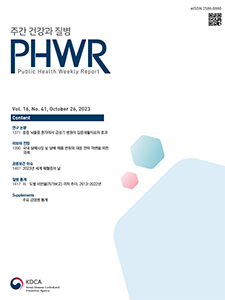Current Issue
Vol.16 No.41, October 26, 2023
-
Original Articles 2023-10-26
 0
0
 1398
1398
 330
330
Effects of Intensive Rehabilitation in the Acute Hospital in Patients with Severe Stroke: The Korean Stroke Cohort for Functioning and Rehabilitation Study
Dae Hyun Kim, Deog Young Kim, Jongmin Lee, Min Kyun Sohn, Min-Keun Song, Yong-Il Shin, Yang-Soo Lee, Min Cheol Joo, So Young Lee, Jeonghoon Ahn, Gyung-Jae Oh, Young Hoon Lee, Junhee Han, Ho Seok Lee, Yun-Hee Kim, Won Hyuk Chang
Public Health Weekly Report 2023; 16(41): 1371-1389 https://doi.org/10.56786/PHWR.2023.16.41.1 Abstract
AbstractThe aim was to investigate the effects of intensive inpatient rehabilitation during the subacute phase to improve functional recovery at 3 months after stroke onset in patients with severe stroke. This study presents the retrospective analysis of the Korean Stroke Cohort for Functioning and Rehabilitation. The stroke patients who were not discharged home were defined as severe stroke patients requiring additional inpatient care. Among the severe stroke patients, those who were transferred to the rehabilitation unit of the same hospital were defined as the intra-hospital transfer group; those who were transferred to the rehabilitation units of other hospitals or rehabilitation specialty hospitals were defined as the inter-hospital transfer group; and those who were transferred to nursing hospitals, oriental hospitals, or nursing homes were defined as the non-intensive rehabilitation group. Multifaceted face-to-face functional assessments, including the National Institutes of Health Stroke Scale (NIHSS) and the Korean Modified Barthel Index (K-MBI), obtained from baseline to 3 months after stroke onset. Multifactorial functional assessments were compared among the three groups by ANOVA with post hoc analysis. In terms of the change from baseline to 3 months, a significant improvement decrease in NIHSS and K-MBI was observed in the intra-hospital transfer group, followed by the inter-hospital transfer group, then the non-intensive rehabilitation group, respectively (p<0.05). This study demonstrated that intensive inpatient rehabilitation in the same hospital during the subacute phase could significantly improve functional outcome at 3 months after stroke onset in patients with severe stroke.
-
Review & Perspective 2023-10-26
 1
1
 932
932
 192
192
Changes in the Domestic Tobacco Market and Tobacco Products, and Challenges to Prepare Strategies for Response
Sungkyu Lee, Yejeong Kim, Jinyoung Kim, Susan Park, Sung-il Cho
Public Health Weekly Report 2023; 16(41): 1390-1406 https://doi.org/10.56786/PHWR.2023.16.41.2 Abstract
AbstractAs the range of tobacco products diversifies, the perception that “ tobacco=cigarette” remains unchanged, which calls for changes in tobacco control policies. This study focuses on identifying the types and characteristics of tobacco products besides cigarettes available and used in Republic of Korea (ROK), as well as anticipating products that are likely to enter the country in the future. The study investigated the official websites and social media channels of major tobacco manufacturers and analyzed recently sold electronic cigarettes (e-cigarettes) by visiting offline stores. New tobacco products have been launched using marketing messages like odor reduction and reduced harm, while smokeless tobacco products are sold in various types. Tobacco companies are using “ smoke-free” expressions to describe the lower risk of new tobacco products compared to conventional cigarettes. The devices of heated tobacco products provide a cleaner and more convenient smoking experience, with a growing number of flavors. E-cigarettes have become very diverse, with over 40 types of devices and 200 types of liquids sold in a single store, classified according to the method of inhaling, nicotine content, and flavor and aroma. Future tobacco products anticipated in ROK is “nicotine pouch” which is similar to snus and contains nicotine powder instead of tobacco leaves. The emergence of such new tobacco products will bring changes in the tobacco use behavior of Korean smokers who frequently use multiple tobacco products, and as there is a possibility that new health hazards may occur as a result, regulatory policies should be prepared by creating scientific evidence such as health impact studies.
-
Public Health Issues 2023-10-26
 0
0
 1142
1142
 344
344
2023 World Sepsis Day
Sae-Rom Choi, Sungnam Kim, Sook-Kyung Park, The Korean Society of Critical Care Medicine
Public Health Weekly Report 2023; 16(41): 1407-1416 https://doi.org/10.56786/PHWR.2023.16.41.3
World Sepsis day is celebrated around the world every year on September 13th, with various events such as education and campaigns being held to raise awareness of sepsis. A symposium is held annually in the Republic of Korea to mark World Sepsis Day, and this year, the public hearing was conducted to develop at Sepsis Treatment Guideline. The Korea Disease Control and Prevention Agency will make continuous efforts in cooperation with related academic societies and associations to reduce the number of deaths and the socioeconomic losses caused by sepsis.
-
QuickStats 2023-10-26
 1
1
 790
790
 272
272
Trends in the Prevalence Gap of Obesity (Self-Reported) between Cities or Provinces, during 2013–2022
Public Health Weekly Report 2023; 16(41): 1417-1418 https://doi.org/10.56786/PHWR.2023.16.41.4

pp. 1~2097
Most Keyword
?
What is Most Keyword?
- It is the most frequently used keyword in articles in this journal for the past two years.
Most Read
-
Waterborne and Foodborne Disease Outbreaks in the Republic of Korea, 2023
Myung-Jae Hwang, So Yeon Park, Hyungjun Kim, Se Jeong Yang, Sungchan Yang, Jin Seon Yang
Public Health Weekly Report 2025;18: 17-32 https://doi.org/10.56786/PHWR.2025.18.1.2 -
Implementation Plan for the Coronavirus Disease 2019 Vaccination for the 2024–2025 Season: Recommendations of the 6th Expert Committee on Immunization Practices
Hyewook Hwang, Wookeon Lee, Seohyeon Ahn, Young-Sook Choi, Seunghyun Lewis Kwon, Dongwoo Lee, Eun Hwa Choi, SokGoo Lee
Public Health Weekly Report 2025;18: 90-102 https://doi.org/10.56786/PHWR.2025.18.2.3
Editorial Office
+82-43-719-7569





 Full Text
Full Text Cite
Cite


